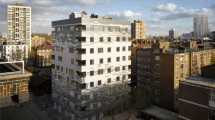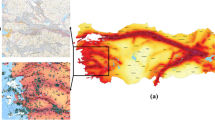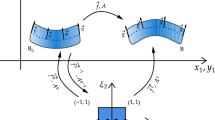Abstract
When a fire develops within the fire compartment of a building, the columns in the compartment are heated, whereas the beams and columns outside the compartment remain cold. Hence, the relative stiffness ratio between the cold members and heated column increases. Consequently, the end-rotational restraint on the heated column is increased, and the effective buckling length of the heated column becomes shorter compared with the ambient temperature condition. However, studies regarding the effect of increased end rotational restraint on heated columns are rare. Although some recommendations to consider this effect are available in representative design standards, they are suggested under limited or ideal conditions and hence not applicable under general conditions. In this study, a procedure for calculating the effective length factor of non-sway steel columns with general end restraints at elevated temperatures is proposed based on the classical Euler column theory and tangent modulus concept. The proposed procedure is validated based on a test-backed nonlinear finite element analysis. It is shown that the proposed equations can be combined with the existing column buckling curve to predict the column buckling strength with significantly increased accuracy compared with the methods suggested by representative design standards.

























Similar content being viewed by others
References
Agarwal, A., & Varma, A. H. (2011). Design of steel columns at elevated temperatures due to fire: Effects of rotational restraints. Engineering Journal, 48, 297–314.
Ali, F., & O’Connor, D. (2001). Structural performance of rotationally restrained steel columns in fire. Fire Safety Journal, 36, 679–691.
American institute of steel construction (AISC). (2016). Specification for structural steel buildings (AISC 360–16). Chicago: AISC.
DSS. (2012) Abaqus analysis user’s manual volume IV: Elements. USA: DSS.
European committee for standardization (CEN). (2005). Eurocode 3: design of steel structures, part 1–2: General rule—structural fire design (EN 1993-1-2). ECS.
Franssen, J. M., Schleich, J., & Cajot, L. (1995). A simple model for the fire resistance of axially loaded members according to Eurocode 3. Journal of Constructional Steel Research, 35, 49–69.
Franssen, J. M., Talamona, D., Kruppa, J., & Cajot, L. G. (1998). Stability of steel columns in case of fire: Experimental evaluation. Journal of Structural Engineering, 124, 158–163.
Morovat, M. A. Creep buckling behavior of steel columns subjected to fire (Doctoral dissertation). 2014.
Morovat, M. A., Engelhardt, M. D., Helwig, T. A., & Taleff, E. M. (2016). Experimental examination of creep buckling of steel columns in fire. Structural Stability Research Council (pp. 248–261).
Takagi, J., & Deierlein, G. G. (2007). Strength design criteria for steel members at elevated temperatures. Journal of Constructional Steel Research, 63, 1036–50.
Talamona, D., Franssen, J. M., Schleich, J. B., & Kruppa, J. (1997). Stability of steel columns in case of fire: Numerical modeling. Journal of Structural Engineering, 123, 713–720.
Valente, J. C., & Neves, I. C. (1999). Fire resistance of steel columns with elastically restrained axial elongation and bending. Journal of Constructional Steel Research, 52, 319–331.
Varma, A. H., Agarwal, A., Hong, S. D., & Prasad, K. (2008). Behavior of steel building structures with perimeter MRFs under fire loading effects. In Proceedings of the fifth international conference on structures in fire. Nanyang Technological University (pp. 266-277).
Wang, Y. C., & Davies, J. M. (2003a). An experimental study of non-sway loaded and rotationally restrained steel columns assemblies under fire conditions: Analysis of test result and design calculations. Journal of Constructional Steel Research, 59, 291–313.
Wang, Y. C., & Davies, J. M. (2003b). Fire tests of non-sway loaded and rotationally restrained steel column assemblies. Journal of Constructional Steel Research, 59, 359–383.
Yura, J. A. (1971). The effective length of column in unbraced frame. Engineering Journal, 8, 37–42.
Acknowledgements
The authors acknowledge the support provided by the Institute of Construction and Environmental Engineering at the Seoul National University.
Author information
Authors and Affiliations
Corresponding author
Additional information
Publisher's Note
Springer Nature remains neutral with regard to jurisdictional claims in published maps and institutional affiliations.
Appendix
Appendix
The following symbols are used hereincx
- \(E\left(T\right)\) :
-
Elastic modulus of steel at temperature \(T\)
- \({E}_{t}\left(T\right)\) :
-
Tangent modulus of column at temperature \(T\)
- \({E}_{0}\) :
-
Elastic modulus of steel at ambient temperature
- \({F}_{cr}\left(T\right)\) :
-
Critical stress of column at temperature \(T\)
- \({F}_{e}\left(T\right)\) :
-
Euler stress of column at temperature \(T\)
- \({F}_{FEM}\) :
-
Critical stress obtained from finite element analysis
- \({F}_{p}\left(T\right)\) :
-
Proportional limit of steel at temperature \(T\)
- \({F}_{p0}\) :
-
Proportional limit of steel at ambient temperature
- \({F}_{r}\) :
-
Maximum residual stress in wide-flange section at ambient temperature
- \({F}_{y}\left(T\right)\) :
-
Yield stress of steel at temperature \(T\)
- \({F}_{y0}\) :
-
Yield stress of steel at ambient temperature
- \(I\) :
-
Moment of inertia
- \(K\) :
-
Effective buckling length factor of column
- \({K}_{Euler}\) :
-
Effective buckling length factor of Euler column
- \({K}_{FEM}\) :
-
Effective buckling length factor obtained from finite element analysis
- \({K}_{pr\left(AISC\right)}\) :
-
Effective buckling length factor calculated via proposed equation using tangent modulus reduction factor from AISC column curve at elevated temperatures
- \({K}_{pr\left(EC3\right)}\) :
-
Effective buckling length factor calculated via proposed equation using tangent modulus reduction factor from EC3 column curve at elevated temperatures
- \({K}_{pr\left(FEM\right)}\) :
-
Effective buckling length factor calculated via proposed equation using numerical results
- \(L\) :
-
Length of column
- \({L}_{c}\) :
-
Effective length of column
- \({P}_{cr}(T)\) :
-
Critical load at temperature \(T\)
- \({P}_{e}(T)\) :
-
Euler load at temperature \(T\)
- \(T\) :
-
Temperature of steel column
- \(k\) :
-
Parameter to consider applied load in elastic column
- \({k}_{E}(T)\) :
-
Retention factor for elastic modulus of steel at temperature \(T\)
- \({k}_{p}(T)\) :
-
Retention factor for proportional limit of steel at temperature \(T\)
- \({k}_{y}(T)\) :
-
Retention factor for yield stress of steel at temperature \(T\)
- \({k}_{\theta }\) :
-
Rotational stiffness of beams and columns adjacent to column end
- \({n}_{c}\) :
-
Parameter to consider column continuity
- \(r\) :
-
Radius of gyration of section
- \(u\) :
-
Parameter to consider applied load in elastic column
- \({u}_{t}\) :
-
Parameter to consider applied load in inelastic column
- \(\alpha\) :
-
Imperfection factor for column buckling in fire design situation
- \({\overline{\lambda }}_{0}\) :
-
Nondimensional slenderness ratio of column at ambient temperature
- \({\overline{\lambda }}_{p0}\) :
-
Nondimensional slenderness ratio of column without effect of rotational restraint at ambient temperature
- \(\overline{\lambda }\left(T\right)\) :
-
Nondimensional slenderness ratio of column at temperature \(T\)
- \({\overline{\lambda }}_{p}(T)\) :
-
Nondimensional slenderness ratio of column without effect of rotational restraint at temperature \(T\)
- \(\mu\) :
-
Elastic rotational stiffness ratio of column end at temperature \(T\)
- \({\mu }_{0}\) :
-
Elastic rotational stiffness ratio of column end at ambient temperature
- \({\mu }_{eq}\) :
-
Equivalent rotational stiffness ratio at temperature \(T\)
- \({\mu }_{t}\) :
-
Inelastic rotational stiffness ratio of column end at temperature \(T\)
- \(\varphi\) :
-
Parameter to determine reduction factor \({\chi }_{fi}\)
- \({\chi }_{fi}\) :
-
Reduction factor for column buckling in fire design
Rights and permissions
Springer Nature or its licensor (e.g. a society or other partner) holds exclusive rights to this article under a publishing agreement with the author(s) or other rightsholder(s); author self-archiving of the accepted manuscript version of this article is solely governed by the terms of such publishing agreement and applicable law.
About this article
Cite this article
Koo, J., Lee, CH. & Shin, D. Effect of Rotational Restraint on Inelastic Buckling of Steel Column at Elevated Temperatures. Int J Steel Struct 23, 564–585 (2023). https://doi.org/10.1007/s13296-023-00713-7
Received:
Accepted:
Published:
Issue Date:
DOI: https://doi.org/10.1007/s13296-023-00713-7




